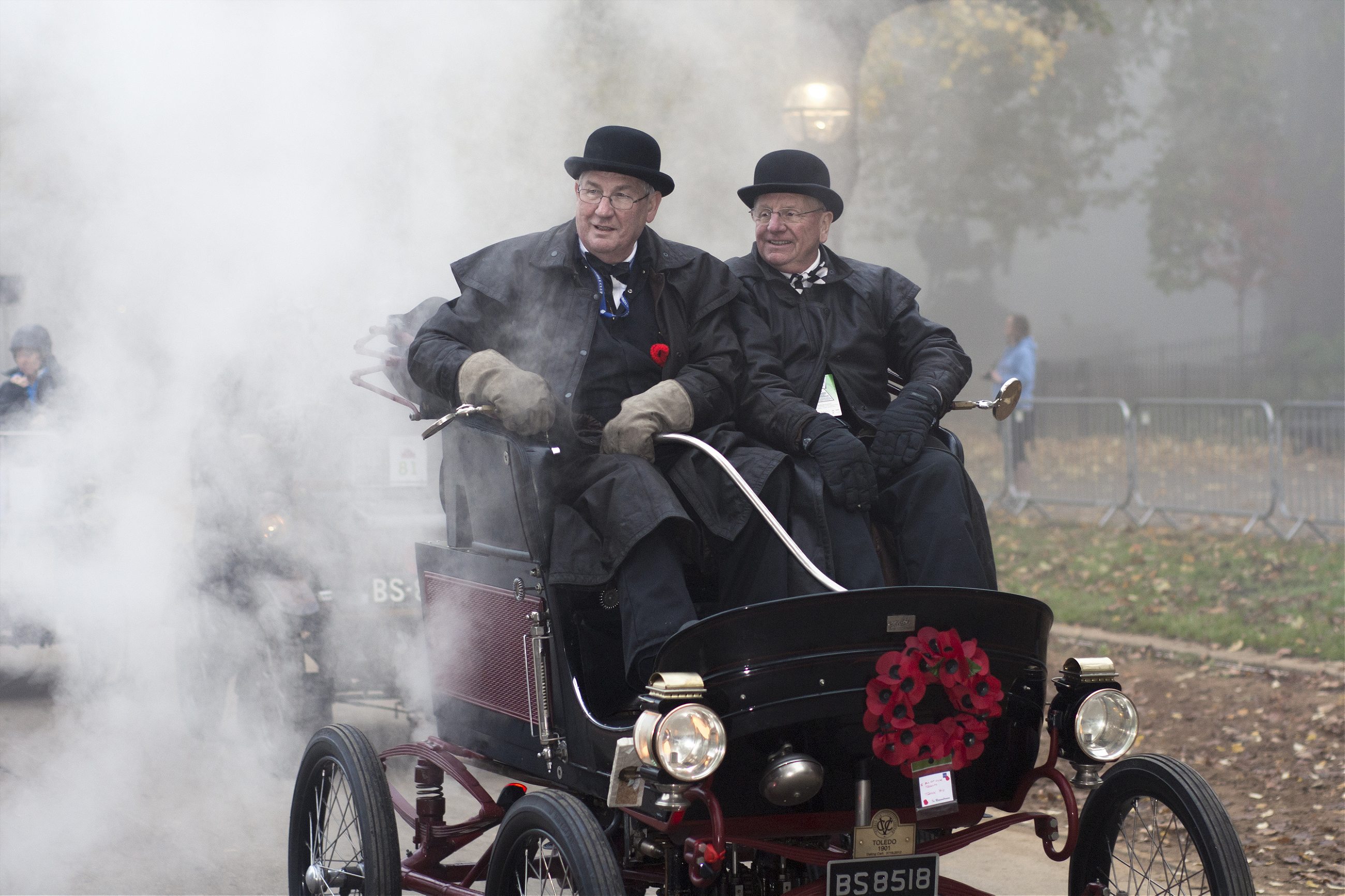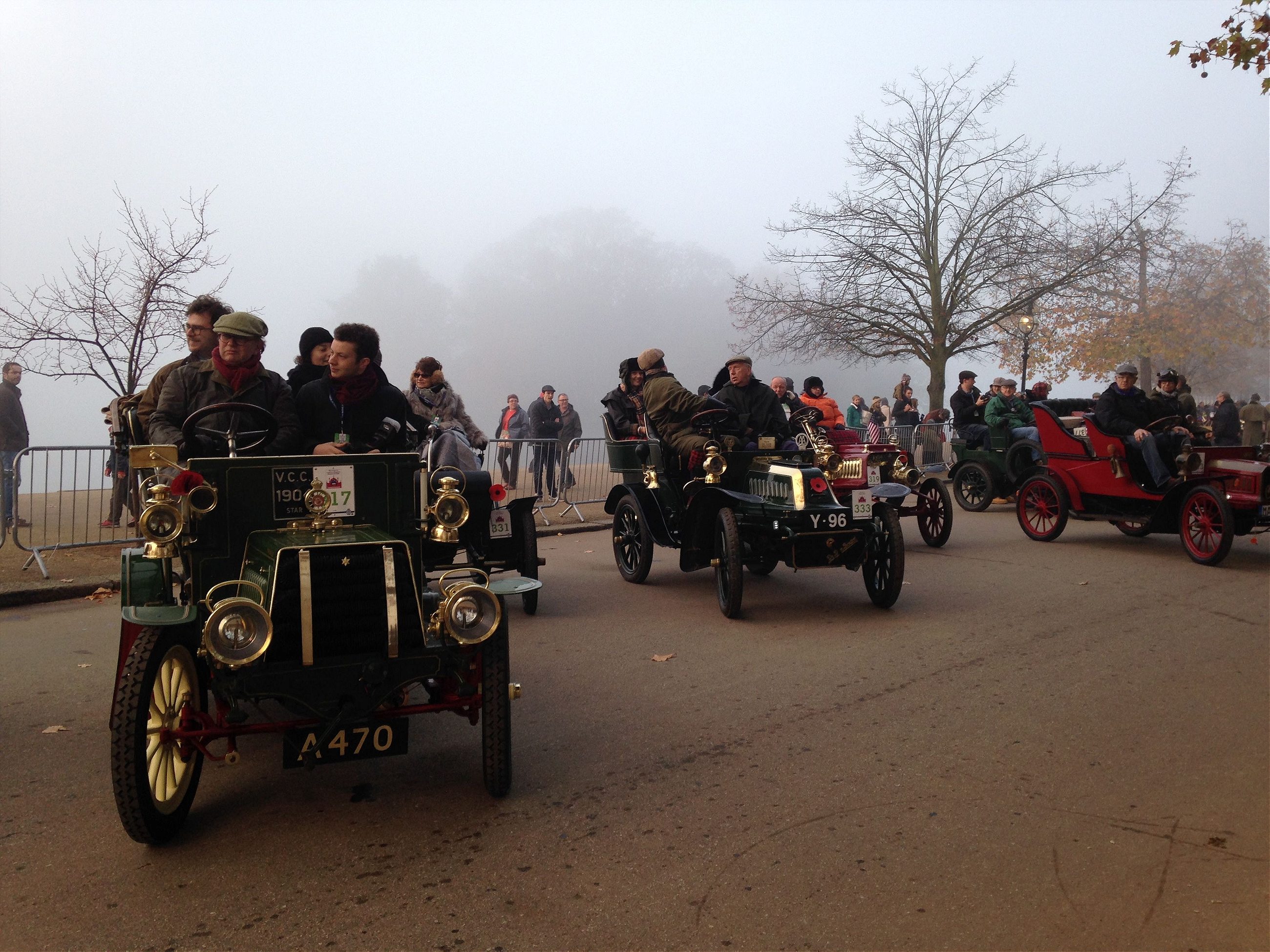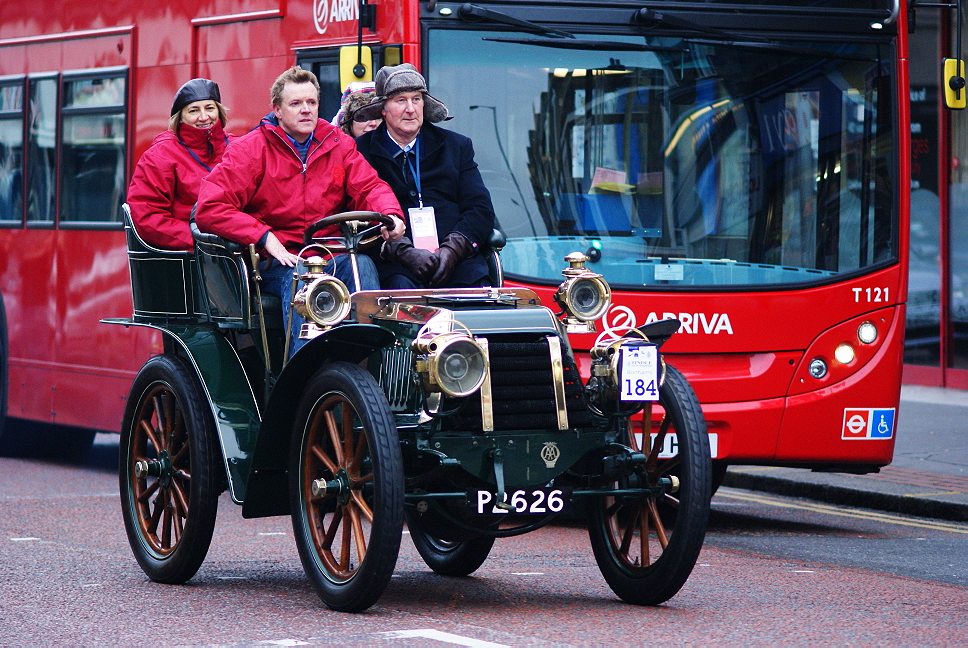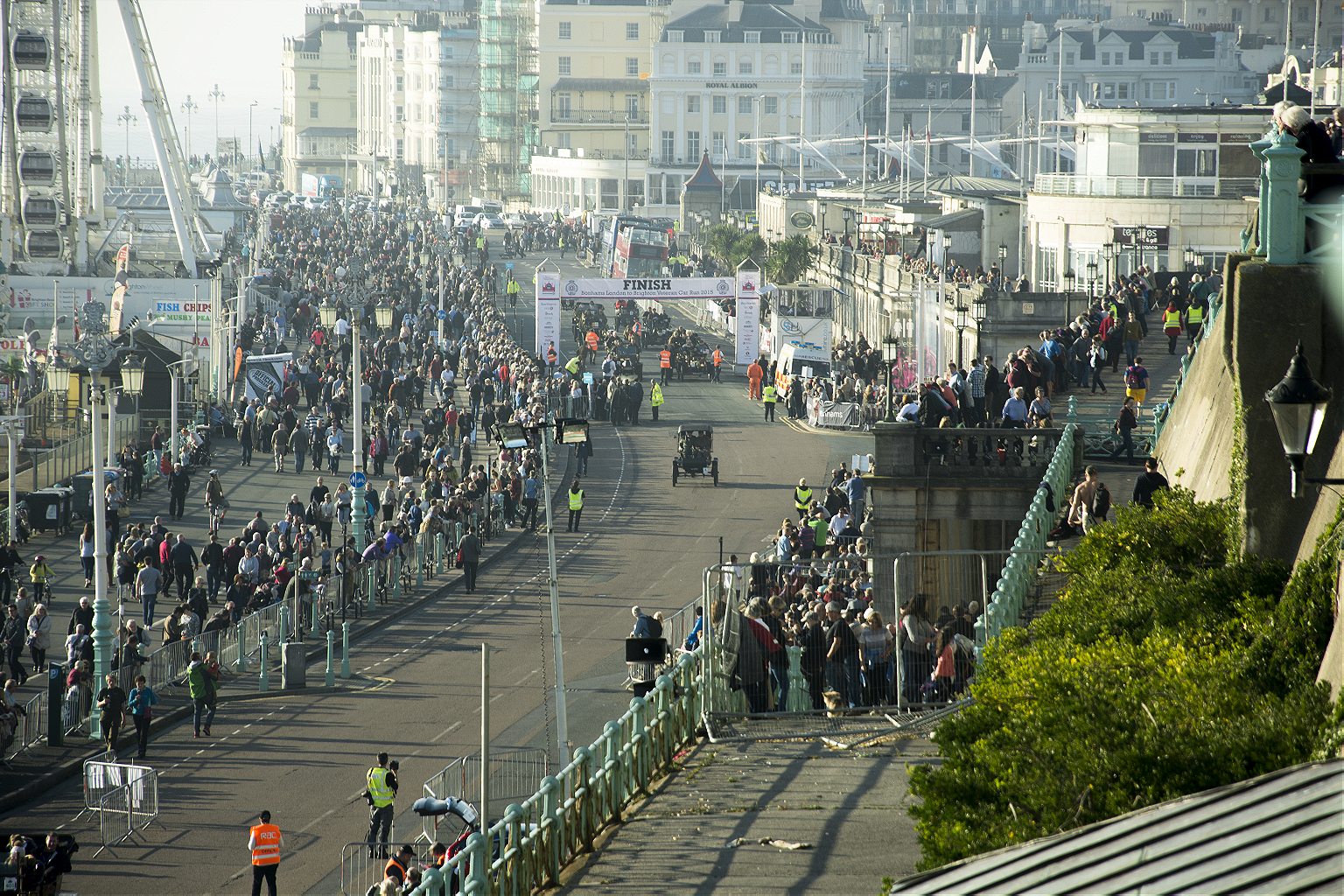Every year, hundreds of veteran cars make the legendary 60-mile journey from London to the seaside town of Brighton.
London looks good in fog. The weather condition is an old coat the city does not try on so often these days, and one that makes it resemble the metropolis it used to be. This morning, the coat has ghosts in its lining.
As the taxi edges closer to Hyde Park, I begin to see them, clattering darkly from the whiteout: veteran cars, museum pieces weaving through the pre-dawn traffic. Their oil lamps are lit, their mud guards are shaking; their drivers are open to the elements, gripping tight at tillers or steering wheels, trying to keep out the November cold. They are on their way to the starting line.
Things were not so different 119 years ago. It was another foggy morning when this event first got rolling. In its nascent years, the motorcar inspired fear and suspicion as much as it did wonder. Early road laws set Britain’s national speed limit at 4mph and mandated that every vehicle had to be preceded by a man on foot carrying a red flag.
These laws were repealed on the 14th November 1896, and that very day a run – a drive – from London to the seaside town of Brighton was organized to celebrate. It was “a run involving much danger and personal risk,” according to early motoring hero Charles Jarrott in his book Ten Years of Motors and Motor Racing.
A hiatus of 31 years followed, then in 1927 the event was staged again, this time with the stipulation that only cars made before 1905 may take part. It has occurred almost every November since.
Though the danger may have faded over the last century, there is still a tension in the air as I make my way along the banks of the Serpentine in Hyde Park, where rank upon rank of ancient vehicles are amassing. It is 6:50 am and the earliest cars are already leaving in clouds of their own steam.

Making it to Brighton in these machines is no forgone conclusion. They are antique boxes of frantically moving parts, of countless stresses and strains, of innumerable ways to go wrong. The event is not a race, but to officially finish the cars must travel the sixty miles to Brighton by 4:30 pm. Of the four hundred plus vehicles that start every year, between a third and a fifth will not reach the coast.
Perhaps it’s my own sense of tension that is heightened. The Brighton Run for me is a family event, an unofficial public holiday inaugurated by my grandfather in 1955. The year before, inspired by my father’s youthful pleading, he had headed up to town to watch the veteran display, and returned home seized by a desire to take part. What happened next is family legend.
A friend tipped him off about a car recently discovered on a bombsite from the Blitz: a 1904 Star (one of the many car manufacturers sunk by the Great Depression). It was an utterly dilapidated vehicle, it had been stored under a pile of fish boxes in a provincial garage. My grandfather asked the garage owner to name his price.
Over the next year he worked on the car for—in his own words—over 1,600 hours. Waking at five every morning, he tinkered in the garage until work proper began, and then was back at it every night. He lost over a stone in weight, but the car was ready in time. My seven-year-old father named the car “Twinkle”, in reference to the vehicle’s make. The name was emblazoned on its bonnet: a character was born.

Fifty-nine years later and she—yes, I mean Twinkle—has reached Brighton every one of them. My grandfather has since passed away, and my father has taken the tiller. Many times the race has been closely run, and every outing feels like we are adding more cards to the tower: one day something has to slip. Just last year, by the roadside in the driving rain, we mercilessly hacksawed away at the engine’s 100-year-old piping trying to solve a fuel blockage, the Run’s closing vehicle loitering behind us like a kind of death. We limped into Brighton with minutes to spare. Thus the tension: this year will be the sixtieth run. And as arbitrary as milestones are, they matter.
My family’s story is not unique. There is something about the Brighton Run that attracts legacies, and although in recent years it has become increasingly a game played only by the very wealthy, there are still many for whom it is more lifestyle than mere event, and their passion infuses everything. All know that they are playing with museum artifacts, but also that a machine not moving is half a thing.
The evening before the run, a cocktail party is hosted at the Royal Automobile Club on Pall Mall in London. There, champagne in hand, I moved among the suited crowds, collecting stories. Old men with boardroom physiques and wine-dyed faces told me tales of unlikely roadside heroics, of wheels falling from full tilt cars, of whole engine rebuilds performed against the clock in desolate lay-bys, of veteran cars that literally had to be pushed the last ten miles in order to get them across the line.
Their attitude harks back to the very earliest days of motoring, back to when the industry was a wild west of innovation: steering wheels, engine location, car shape, and even what fuel to use were all subjects for debate. Cars were dangerous things and their drivers reckless pioneers. Races were not so much competed against one another, but against the machines themselves. The simple act of finishing was all.
One terrific story from those days, told by motoring hero Jarrott, involves the author commandeering a rural hotel’s 18th -century bookcase because it was made of sturdy enough material to secure the cracked chassis of his car. The theft was performed at three in the morning, after a black-tie party, itself after a hard day’s racing. The engineering work enacted in said hotel’s courtyard, during which Jarrott’s mechanic—certainly blind drunk—succeeded in punching a hole in his own arm. The pair were nevertheless, ready to race on again at dawn.
As I moved among the crowds at the cocktail party, I was struck by a fierce sense of individualism among the competitors. They are, by and large, small business owners, unused to having others tell them what to do, deeply committed to their own values, to their eccentricity. They are the kind of people perhaps too fond of the phrase ‘You make your own luck.’
In Hyde Park, however, they are almost unrecognizable. Their cocktail suits have been traded for leather and wax cotton, adorned by accessories from flying goggles to deerstalker hats. Without the cars, a passer-by could easily mistake the scene for a vast steampunk cosplay convention, despite it being hugely unlikely that the participants would know what one of those was. They look, and moreover are the part.

A whistle blows; one of the run’s marshals emerges from the fog. In his high-visibility orange he stands out against the murk and the crowds. He is clutching a sign that says ‘Move Now.’ My father bends to Twinkle’s starting handle, he pauses for a couple of seconds, then throws the engine over.
The car chuckles into life, and the perfume of un-burnt petrol rises through the dawn air. All about us other vehicles are doing the same. It is a cacophony of ancient engines churning as they are meant to. The cars’ white exhaust fumes pump into the air and a man-made fog joins the natural one. My mum, my sister and I pile onto Twinkle. For the sixtieth year in a row, her clutch is released. We inch forward, joining the cavalcade on our way to Brighton.
Spectators line the route. They are a testament to the British public’s interest in the peculiar, to their willingness to brave the elements in the name of an event. I can almost hear the radio announcement: “In spite of the inclement weather…” They are families and enthusiasts, and late night clubbers rubbing their eyes, unsure of what they are seeing. This being the morning after Halloween, there are also some still in fancy dress; hungover zombies lurching from the mist to wave at us.
Already there are casualties lining the route
Already, though, we have seen casualties lining the route. Some total non-starters, left impotently static in Hyde Park, while others were pulled up in the misty shadow of Buckingham Palace, or along Horse Guards Parade: their bonnets removed, their owners poking anxiously at their insides. Twinkle seems to be going well, however; her engine is thrumming steadily and she is surging forward at her heady top speed: about 28mph.
Why the original Motor Car Club decided the 1896 run should be from London to Brighton is not recorded. Likely it just represented a good distance for celebrating the cars’ newly granted freedom, plus young men had been testing their endurance horse-riding skill on the route since Regency times.
In the modern day, the path out of London is a suburban slog. From Brixton to Croydon, all the way out as far as Gatwick Airport, the city is slow to give up to the country. And within this belt of 20th Century development, the cars begin to seem more of an anachronism. The weight of their years begins to show, more fall by the way side: engine trouble mostly, but that covers a multitude of mishaps.
Nevertheless, the run’s spirit persists. Every vehicle and its passengers are their own island against the modern sprawl. They zigzag down bus lanes, take small heed of traffic lights, and ignore modern vehicles whenever safety allows—in fact, safety seldom allows, but they do it anyway. Occasionally two veterans will find themselves locked in a private race, jostling for position.

And still everywhere there are the spectators. For those whose homes line the route, the run is as much of a tradition as it is for the people who are on it. And what sight could be more representative of a certain type of Britishness than deckchairs in front of semi-detached houses, their occupants swaddled in woolen rugs and clutching mugs of tea?
The route is also a magnet for all manner of other hobby groups and enthusiasts. Everything from 1960s bubble cars to vintage farm machinery is represented. Here is a world forged in garden sheds and private garages now put on display.
Twinkle is still running well as we head past Gatwick Airport—planes thundering invisible overhead—and break into open country. It is a hard feeling to express, this love for a mere thing, but one that I am sure that most of the run’s other participants would understand. Particularly when everything is working as it should, when the car’s symphony of mechanics and combustion rises, keeping regular time. You believe that the vehicle is alive, that it smells its stable somehow, and wants to take you home.
The run’s final and hardest test is an incline called Clayton Hill. This contour in the landscape is the kind of thing that you would hardly notice in a modern car, but it can be the life or death of a veteran vehicle. Last year, as we approached it, the rain was still coming down in sheets, and Twinkle only coughing her way forward, running repairs having returned her to barely half-strength. All eyes were on the clock.
As we queue up to cross the finish line, a slight sense of anti-climax pervades. Sixty completed runs is no small accomplishment, but at the same time a number is just a number. No one is covered in engine grease this year; no parts of the car had to be hacked off and replaced to arrive. Instead, there is just relief and an anticipation of the annual Brighton Run dinner, where participants again will shed their overalls for tuxedos and cocktail dresses, and where war stories are shared.

I had to get out, to run alongside, to push. And still we almost didn’t make the top. This year, it’s like the hill is not there at all. We reach the summit and at long last break free from the fog. From here everything is plain sailing.
The run ends, as it always does, at Madeira Drive on the seafront in Brighton. This time, to bright sunshine and applauding crowds. Here the veterans retake the time period again, they are no longer ghosts. They have proved themselves in arriving, and in so doing it seems, become for a moment more substantial again, the primary users of the road.